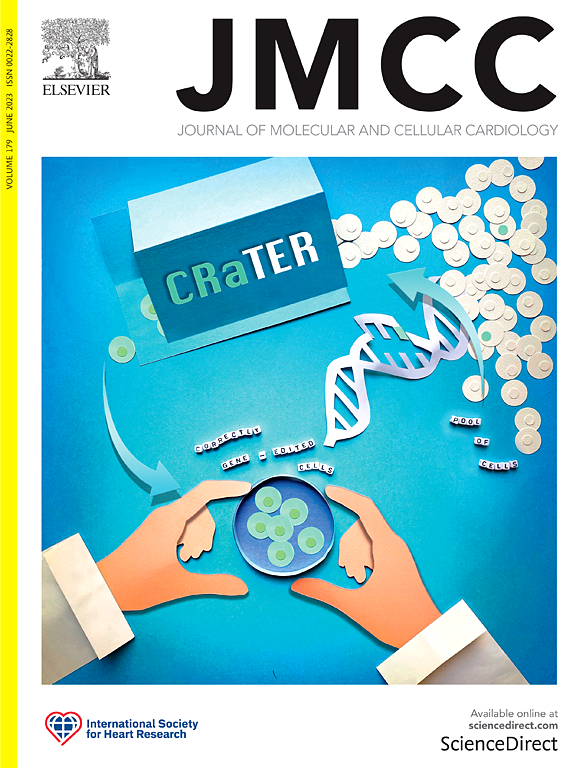mfn2介导的线粒体相关内质网膜减少有助于舒尼替尼诱导的内皮功能障碍和高血压。
IF 4.9
2区 医学
Q1 CARDIAC & CARDIOVASCULAR SYSTEMS
引用次数: 0
摘要
用酪氨酸激酶抑制剂(TKIs)治疗癌症患者常导致高血压,但其潜在机制尚不清楚。本研究旨在研究线粒体形态和功能,特别是线粒体相关内质网膜(MAMs)在舒尼替尼诱导的高血压中的作用。方法:采用体外和体内实验的方法,对人脐静脉内皮细胞(HUVECs)和C57BL/6小鼠主动脉内皮细胞(C57BL/6)在载药或舒尼替尼治疗条件下的活性氧(ROS)、一氧化氮(NO)、内皮依赖性血管舒张、全身血压和线粒体功能进行评估。结果:舒尼替尼增加了huvec中线粒体ROS积累,降低了氧气消耗率、ATP产生和线粒体钙([Ca2+]M)水平,并损害了内皮型一氧化氮合酶(eNOS)和一氧化氮(NO)信号。此外,舒尼替尼还能降低线粒体膜电位,延长线粒体,降低MAMs。值得注意的是,这些效应被一种强化MAMs的腺病毒连接体(ad -link)逆转。利用aav - flt1连接物对MAMs进行工程化增强,通过恢复小鼠内皮依赖性松弛,显著减轻舒尼替尼诱导的高血压,突出了MAMs在这一过程中的关键作用。进一步的分析表明,舒尼替尼增强了akt介导的mitofusin 2 (MFN2)的表达,导致线粒体伸长,并诱导肌醇1,4,5-三磷酸受体1 (IP3R1)在Y1737/Y1738残基上的去磷酸化,降低了[Ca2+]M。我们的研究表明,MFN2表达增加和IP3R1去磷酸化在舒尼替尼诱导的MAMs减少和[Ca2+]M稳态中至关重要。结论:舒尼替尼诱导内皮细胞线粒体功能障碍,Akt/ mfn2介导的MAMs和线粒体伸长减少,IP3R1去磷酸化,导致内皮功能障碍和高血压。我们的结果为对抗tki诱导的高血压提供了潜在的治疗靶点。本文章由计算机程序翻译,如有差异,请以英文原文为准。
MFN2-mediated decrease in mitochondria-associated endoplasmic reticulum membranes contributes to sunitinib-induced endothelial dysfunction and hypertension
Treatment of cancer patients with tyrosine kinase inhibitors (TKIs) often results in hypertension, but the underlying mechanism remains unclear. This study aimed to examine the role of mitochondrial morphology and function, particularly mitochondria-associated endoplasmic reticulum membranes (MAMs), in sunitinib-induced hypertension.
Methods
Both in vitro and in vivo experiments performed to assesse reactive oxygen species (ROS), nitric oxide (NO), endothelium-dependent vasorelaxation, systemic blood pressure, and mitochondrial function in human umbilical vein endothelial cells (HUVECs) and C57BL/6 mouse aortic endothelial cells, under vehicle or sunitinib treatment condition.
Results
Sunitinib increased mitochondrial ROS accumulation, decreased oxygen consumption rate, ATP production, and mitochondrial calcium ([Ca2+]M) levels, and impaired endothelial nitric oxide synthase (eNOS) and nitric oxide (NO) signaling in HUVECs. In addition, sunitinib also decreased mitochondrial membrane potential, elongated mitochondria, and reduced MAMs. Remarkably, these effects were reversed by an adeno-virus linker (Ad-linker) that reinforces MAMs. Engineered augmentation of MAMs using AAV-FLT1-linker significantly mitigated sunitinib-induced hypertension, by restoring endothelium-dependent relaxation in mice, highlighting the crucial role of MAMs in this process. Further analyses revealed that sunitinib enhanced Akt-mediated expression of mitofusin 2 (MFN2), causing mitochondrial elongation, and induced dephosphorylation of inositol 1,4,5-trisphosphate receptor type 1 (IP3R1) at residues Y1737/Y1738, reducing [Ca2+]M. Our study suggests that increased MFN2 expression and IP3R1 dephosphorylation are critical in sunitinib-induced MAMs reduction and [Ca2+]M homeostasis.
Conclusion
Sunitinib induces mitochondrial dysfunction, Akt/MFN2-mediated decrease in MAMs and mitochondrial elongation, and IP3R1 dephosphorylation in endothelial cells, leading to endothelial dysfunction and hypertension. Our results provide the potential therapeutic targets for combating TKI-induced hypertension.
求助全文
通过发布文献求助,成功后即可免费获取论文全文。
去求助
来源期刊
CiteScore
10.70
自引率
0.00%
发文量
171
审稿时长
42 days
期刊介绍:
The Journal of Molecular and Cellular Cardiology publishes work advancing knowledge of the mechanisms responsible for both normal and diseased cardiovascular function. To this end papers are published in all relevant areas. These include (but are not limited to): structural biology; genetics; proteomics; morphology; stem cells; molecular biology; metabolism; biophysics; bioengineering; computational modeling and systems analysis; electrophysiology; pharmacology and physiology. Papers are encouraged with both basic and translational approaches. The journal is directed not only to basic scientists but also to clinical cardiologists who wish to follow the rapidly advancing frontiers of basic knowledge of the heart and circulation.

 求助内容:
求助内容: 应助结果提醒方式:
应助结果提醒方式:


